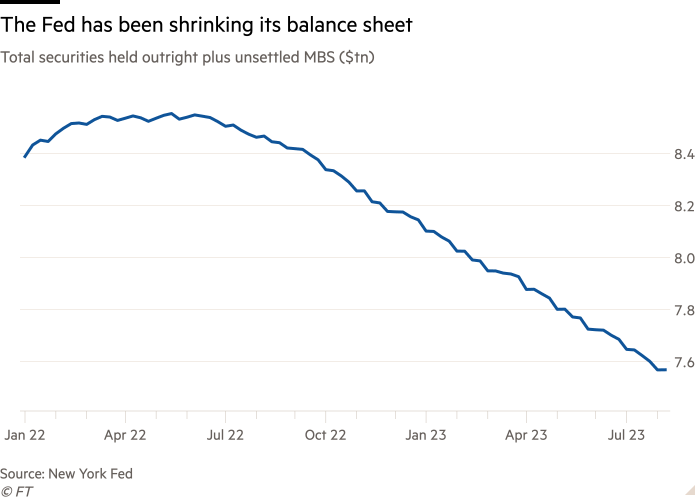
Obtain free The QE retreat updates
We’ll ship you a myFT Each day Digest electronic mail rounding up the newest The QE retreat information each morning.
The Federal Reserve’s drive to shrink its swollen stability sheet is poised to hit $1tn this month, a big milestone within the US central financial institution’s try to reverse years of straightforward pandemic-era financial coverage as buyers warn additional reductions threaten to shake monetary markets.
The US central financial institution purchased trillions of {dollars} of presidency bonds and mortgage-backed securities to assist stabilise the monetary system in the course of the early levels of the Covid-19 pandemic, however final spring began letting its holdings mature with out changing them.
As of August 9, the Fed’s portfolio had shrunk by $0.98tn for the reason that portfolio’s peak of $8.55tn in Might final yr, and evaluation of weekly knowledge suggests it’s on monitor to cross $1tn earlier than the top of the month.
By eradicating one of many largest patrons from authorities bond markets, the Fed’s stability sheet discount — generally known as quantitative tightening — provides to the provision of debt that non-public buyers have to soak up.
For the central financial institution, quantitative tightening could be a precarious path. It was compelled to finish its earlier try in 2019 after the stability sheet unwinding contributed to a pointy spike in borrowing prices that spooked markets.
Up to now, the newest spherical of tightening has proceeded easily, regardless of occurring at nearly twice the tempo of 2018-2019 reductions. Traders say the resilience displays the truth that the worldwide monetary system has been awash in money for the reason that pandemic, however the backdrop for additional decreases is turning into more difficult.
“The second trillion value of stability sheet discount is prone to have extra of an influence,” mentioned Jay Barry, co-head of US charges technique at JPMorgan. “The primary trillion occurred in opposition to the backdrop of the federal funds price transferring quickly larger, and the second trillion issues extra as a result of it’s coming in opposition to the backdrop of a faster improve within the tempo of Treasury provide.”
The Fed goals to chop one other $1.5tn from its stability sheet by mid-2025, simply because the US authorities is dramatically rising the quantity of debt it points, and as demand from overseas buyers wanes.
That threatens to drive up borrowing prices for the federal government and for corporations, and would trigger losses for the various buyers who’ve piled into bonds this yr anticipating yields to fall because the cycle of rate of interest rises attracts to a detailed.

Manmohan Singh, a senior economist on the IMF, mentioned an extra $1tn of QT could be equal to lifting the federal funds price by one other 0.15 to 0.25 proportion factors.
“With rates of interest stabilising, the consequences of extra QT could also be simpler to see,” he mentioned.
The Treasury division has ramped up bond issuance this yr to fill the hole between decrease tax income and better authorities spending. Earlier this month, the company introduced that it will improve the sizes of its auctions within the coming quarter, and that there could be additional will increase within the quarters to come back. Meghan Swiber, a charges analyst at Financial institution of America, estimates that some public sale sizes might attain the peaks hit in 2021, on the top of Covid-19 borrowing.
In the meantime, demand from Japan, the most important overseas holder of Treasury bonds, is forecast to fall. The Financial institution of Japan in July eased management on its authorities bond market, sending Japanese bond yields to the very best degree in nearly a decade. Increased bond yields have led some buyers to anticipate a big repatriation of Japanese cash, with notable flows out of Treasuries.
QT, even on this situation, is just not anticipated to consequence within the form of liquidity calamity seen in 2019. Not like 4 years in the past, there’s nonetheless a number of money within the monetary system. Though utilization has come down, a particular Fed facility designed particularly to suck up extra money nonetheless has buyers placing $1.8tn into it each night time. Financial institution reserves are decrease this yr, however stay far above the degrees at which the Fed begins to fret.
However some analysts suppose yields within the Treasury market might go up considerably, significantly on longer-dated bonds. Increased yields replicate decrease costs.
“The Fed’s unwind, although it’s passive, ought to result in a steeper yield curve,” Barry mentioned.
“Despite the fact that we’re finished with price hikes, [QT] might affect the yield curve for the remainder of this yr and into subsequent yr as nicely.”
As a result of Treasury yields underpin valuations throughout asset lessons, a big rise would additionally imply larger prices for company debtors and will undermine the rally in equities this yr.
“All of this shuffles across the patrons and the sellers and the market,” mentioned Scott Skyrm, a repo dealer at Curvature Securities. “And, in fact, whenever you transfer issues round, it tends to create extra volatility. I anticipate extra volatility in September and October, as much more issuance comes.”